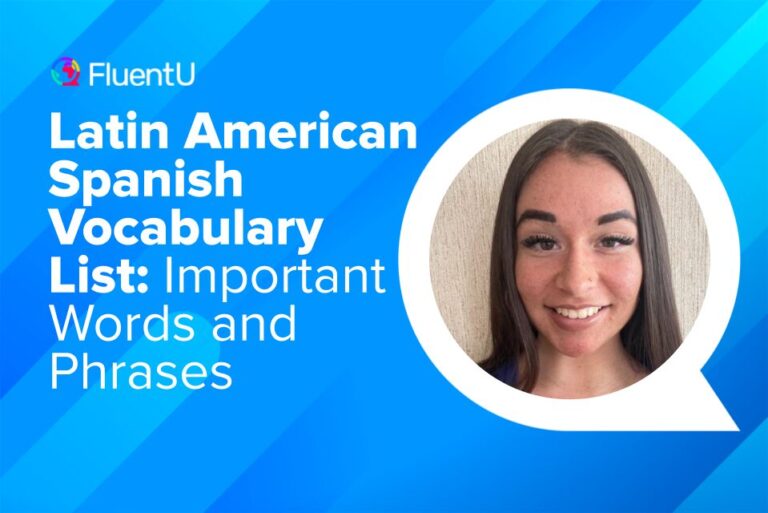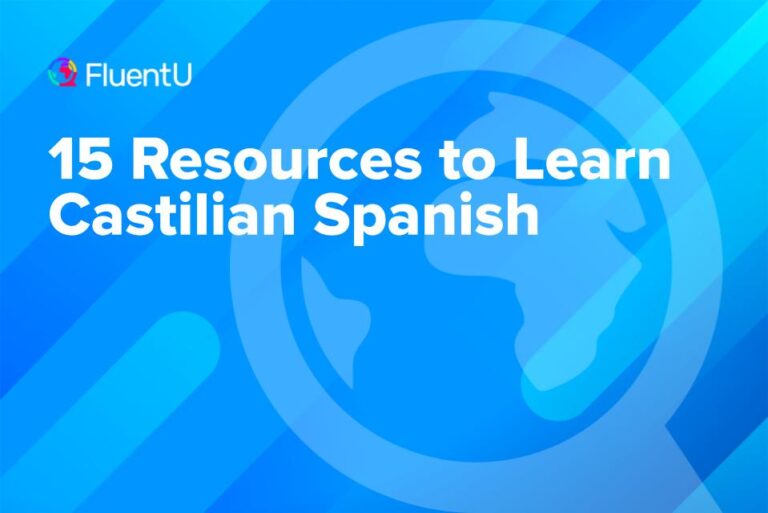Contents
- 1. Pues… (Well…)
- 2. Pues nada (Well, nothing)
- 3. (Vamos) a ver… (Let’s see… / Look…)
- 4. En plan… (Like…)
- 5. Digo… (I mean…)
- 6. O sea… (I mean…)
- 7. Entonces… (So…)
- 8. Así que… (So…)
- 9. Bueno… (Well…)
- 10. Es que… (It’s just that…)
- 11. Este… (Um…)
- 12. ¿Sabes? (You know?)
- 13. Eso… (Like I said)
- 14. En fin (So, that’s it / All in all)
- 15. ¿Vale? / ¿Me entiendes? (Okay? / You get me? / You understand me?)
- 16. Vale, vale, vale (Okay, okay, okay)
- 17. La cosa es (que)… (The thing is…)
- 18. Quiero decir (que) / Es decir (I want to say / Which is to say)
- 19. A lo que me refiero es… (What I mean is)
- How to Learn Spanish Filler Words
- Why Learn Spanish Filler Words?
- And One More Thing…
Spanish Filler Words to Sound More Natural

Um, uh, like, I guess, I mean… Whether we like it or not, these words are a part of our natural speech patterns, and they can be extremely difficult to get rid of.
But did you know Spanish also has a variety of filler words? They’re called muletillas (literally: little crutches). Here are 19 of the most common ones, plus how to employ them in your everyday life.
Download: This blog post is available as a convenient and portable PDF that you can take anywhere. Click here to get a copy. (Download)
1. Pues… (Well…)
Throw pues at the beginning of a sentence to show uncertainty or indecisiveness.
You can also use it to stall while you think of the best way to respond to someone (or how to conjugate a tricky verb).
It sits really well when followed by no (no) or sí (yes).
For example:
¿Quieres salir esta noche?
(Do you want to go out tonight?)
Pues… no sé, tengo mucho sueño…
(Well… I don’t know, I’m really tired…)
Here’s an example with pues sí:
¿Te apetece un café?
(Do you fancy a coffee?)
Pues sí.
(Well [now that you mention it] yes.)
2. Pues nada (Well, nothing)
On top of being a filler word, pues nada is also used as an easy response to ¿qué estás haciendo? (what are you doing?).
(And the guy who was interviewing me said “thanks for coming, we’ll call you” and… well, they haven’t called me… so… I don’t think they’ll give me the position.)
3. (Vamos) a ver… (Let’s see… / Look…)
A ver directly translates as “to see.” As a filler word, use it like the English phrase “let’s see…” or “look…”
A ver… ¿qué podemos hacer esta noche?
(Let’s see… what can we do tonight?)
You can also use vamos a ver:
Vamos a ver qué hay para hacer esta noche.
(Let’s see what there is to do tonight.)
Vamos a ver lo que pasa.
(Let’s see what happens.)
A ver and vamos a ver can also be used when you want to explain yourself:
A ver… no quiero decir que no sea un buen actor.
(Look… I’m not saying he’s not a good actor.)
Both a ver and vamos a ver can also be used to sum up the situation:
Vamos a ver… ella ha dicho que sí, pero él dice que no. ¿Verdad?
(Let’s see… so she has said yes, but he says no. Is that right?)
4. En plan… (Like…)
The filler word of choice for teenagers all over Spain, this versatile phrase is similar to the English “like.”
Spanish adolescents use it all the time in any part of a sentence.
You can use it before describing the way you were doing something.
For example:
Estábamos allí en plan descansando cuando llegó Miguel.
(We were there, like, relaxing, when Miguel arrived.)
No te enfades, lo hice en plan broma.
(Don’t get angry, I meant it like, as a joke.)
5. Digo… (I mean…)
This word comes from the verb decir (to say/tell) and directly translates to “I say.”
It’s used to correct yourself.
Me dijo que la fiesta empieza a las nueve—digo, a las diez.
(She told me the party starts at nine—I mean, at ten.)
6. O sea… (I mean…)
Use o sea to clarify, explain or nuance something you’ve just said.
It’s similar to the English phrases “I mean…” or “in other words…”
Another similar Spanish phrase is es decir .
¿Vas a salir otra vez con él? O sea, ¿lo pasasteis bien?
(You’re going to go out with him again? I mean, you had a good time?)
You can also use it when you realize that what you just said isn’t entirely correct and you want to add extra information:
(I’ve realized that I’ve never traveled on a train, I mean, yes, I’ve traveled on a train, but only on regional trains, not on a long-distance one.)
7. Entonces… (So…)
Entonces is a formal word appropriate for written Spanish.
But in spoken Spanish, it also serves as a handy filler word to throw at the beginning of a sentence:
Entonces, ¿qué vas a hacer?
(So, what are you going to do?)
Entonces also can be used to signal to the listener that you’re going to continue speaking:
Me dijiste que no vas a trabajar mañana, entonces… ¿crees que podrás venir a la fiesta?
(You told me that you’re not going to work tomorrow, so… do you think you’ll be able to come to the party?)
8. Así que… (So…)
Like entonces, así que is a transition word that means “so” or “therefore.”
But you can also use it as a filler word, particularly at the beginning of a sentence.
¿Así que al final fuiste al restaurante?
(So you ended up going to the restaurant?)
You can also use así que bueno or así que nada as filler phrases.
They both mean roughly “so yeah…” or “so anyways…”:
Así que bueno, esa es toda la historia.
(So yeah, that’s the whole story.)
9. Bueno… (Well…)
You can use bueno like pues: at the beginning of the sentence when you’re trying to think of how to respond:
Bueno… lo tengo que pensar un poco más.
(Well… I have to think about it a little more.)
You can use it to express agreement, or when someone proposes an idea that sounds good to you:
Bueno… sí, eso me parece una muy buena idea.
(Well… yeah, that seems like a really good idea to me.)
It also expresses uncertainty when you draw out the e:
¿Te ha gustado la peli?
(Did you like the movie?)
Bueeno… la verdad es que no mucho.
(Well… to tell you the truth, not much.)
A loud or drawn-out bueno can express exasperation, annoyance or disbelief.
For extra emphasis, add the word pero before:
¿Todavía no habéis fregado los platos? ¡Pero bueno!
(You still haven’t washed the dishes? Well then!)
10. Es que… (It’s just that…)
Es que is a great filler word to use when you need to explain yourself or rationalize a decision.
I’ve found it’s especially useful when you need to politely decline, deny or disagree with somebody.
For example:
¿No has terminado la tarea?
(You haven’t finished the homework?)
¡Es que es muy difícil!
(It’s just that it’s really difficult!)
¿Por qué no quieres ir al cine?
(Why don’t you want to go to the movies?)
Es que no me gustan las películas de terror.
(It’s just that I don’t really like horror movies.)
11. Este… (Um…)
This muletilla is commonly used in Mexico.
Like many of the other fillers on this list, the final vowel e is often elongated in this context.
¿Cómo se llama el hermano de tu vecino? Lo acabo de ver en el parque.
(What’s your neighbor’s brother called? I’ve just seen him at the park.)
Este… ¡ah Luis! Se llama Luis. Es el hermano menor de mi vecino Pablo.
(Um… ah Luis! He’s called Luis. He’s my neighbor Pablo’s younger brother.)
12. ¿Sabes? (You know?)
Es muy importante para mí, ¿sabes?
(It’s really important to me, you know?)
You can also use ¿Sabes qué? (You know what?) as an introduction to a sentence:
¿Sabes qué voy a hacer? Voy a dejar mi trabajo y mudarme a Hawái.
(You know what I’m going to do? I’m going to quit my job and move to Hawaii.)
13. Eso… (Like I said)
On its own, you can use eso as a lead-in to a summary or conclusion of a conversation.
It’s a good way to reiterate something that you’ve already said but want to repeat or emphasize.
Pues, eso, que lo siento mucho pero vas a tener que volver mañana.
(Well, like I said, I’m sorry, but you’re going to have to come back tomorrow.)
14. En fin (So, that’s it / All in all)
You can use en fin to end a conversation.
Or use it like eso as a lead-in to a summary or final thought on the conversation.
En fin… pues, me tengo que ir. ¡Hasta luego!
(So, that’s it… well, I have to go. See you later!)
En fin… lo pasamos muy bien hoy, gracias por todo.
(All in all… we had a great time today, thanks for everything.)
15. ¿Vale? / ¿Me entiendes? (Okay? / You get me? / You understand me?)
One example of when you can use these muletillas is when giving directions:
Primero, sigues por esta calle, ¿vale?
(First, you follow this road, okay?)
Here’s an example with me entiendes:
(Look, there’s a sign there that says you can’t go in but, yes, you can go into that street, you understand me? From there…)
16. Vale, vale, vale (Okay, okay, okay)
Repetition is used a lot by many Spanish speakers.
No more is this evident than when you’re using vale (okay) to mean “okay, I totally understand what you’re saying.”
Just lightly repeat the word in a quick stream while nodding your head.
For example, you could use this when listening to someone who is giving you directions to a place:
Vale… vale, vale, vale, vale… sí… sí, te entiendo.
(Okay… yep, yep, yep, yep… right… yes, I understand you.)
17. La cosa es (que)… (The thing is…)
You can take a moment to think after saying la cosa es… because it’s clear you’re going to continue.
You can also repeat it to attract attention in a group conversation.
For example, you could use this muletilla when attracting attention in a heated discussion:
La cosa es que… la gente que tiene el poder no quiere cambiar la situación.
(The thing is that… the people who have the power don’t want to change the situation.)
18. Quiero decir (que) / Es decir (I want to say / Which is to say)
These are great ones to use when you’ve totally messed up what you were saying in Spanish and you want to start the whole point again.
Quiero decir (que) means “I want to say (that)” and es decir is a bit like “which is to say.”
For example, they’re often used when you want to correct yourself after an unsuccessful explanation:
(You’re not understanding me, right? I want to say that the man, which is to say, the plumber, couldn’t do the job because…)
19. A lo que me refiero es… (What I mean is)
This means “what I mean is” or more literally “what I’m referring to is.”
(Look. What I mean is that the people from here don’t understand what the people from there are talking about. You understand me?)
How to Learn Spanish Filler Words
- Listen to native Spanish speakers. If you live in a Spanish-speaking country or have regular language exchanges, this should not be hard—simply go talk to people!
- Immerse yourself in native Spanish media. Spanish movies and TV shows are also good resources where you’ll be able to pick up filler words. The best kind are unscripted television, such as reality TV or talk shows. You could even try listening to podcasts. You’re sure to come across many Spanish filler words, especially in episodes that invite guest speakers or have multiple hosts. Spanish-speaking vloggers are also a good resource for learning filler words. Check out Luisito Comunica and Alex Tienda from Mexico to start.
- Study with an online immersion resource. Thanks to the Internet, you don’t have to travel to immerse yourself in Spanish. For example, FluentU lets you study Spanish with thousands of native Spanish videos
FluentU takes authentic videos—like music videos, movie trailers, news and inspiring talks—and turns them into personalized language learning lessons.
You can try FluentU for free for 2 weeks. Check out the website or download the iOS app or Android app.
P.S. Click here to take advantage of our current sale! (Expires at the end of this month)

- Take note of the words you hear frequently, at the beginning of sentences, or when someone is at a loss for what to say. This is a useful practice during language exchanges or when you’re watching Spanish content.
- Look up filler words you can’t understand or ask a forum. It never hurts to directly ask what the meaning of a word is, but if you don’t want to interrupt the conversation, you can also jot the word or phrase down and look it up later on WordReference.com. WordReference’s forums are a great place to get native speakers’ input on the meanings of colloquial expressions.
Why Learn Spanish Filler Words?
- Spanish speakers use filler words all the time. Knowing them will help you improve your Spanish comprehension skills. Even someone with a good grasp of Spanish vocabulary may have a hard time getting the gist of a casual conversation when every other word is o sea or así que. These words are not always taught in formal Spanish classes, but they’re part of everyday conversation.
- They make your Spanish sound more natural. Muletillas are great connecting words—they form the glue that holds together a sentence and makes it sound fluid and natural. These words can help you express subtle shades of meaning or emotion in the way that native speakers do.
- They buy you time so you can think of how to respond. When I speak Spanish, I despise the intimidating silence that comes when I forget a certain word or verb conjugation. Even worse is relying on English filler words due to nervousness. Inserting “like” and “um” into your spoken Spanish not only makes your Spanish sound disjointed—it also makes it harder for native speakers to understand you.
En fin… This article is an introduction to filler words, which can help bring your Spanish comprehension and conversation to the next level.
These muletillas will help you sound more like a native speaker in no time—it just takes a little practice, ¿sabes?
Pues, eso… study your Spanish muletillas and you’ll thank yourself in the future!
Download: This blog post is available as a convenient and portable PDF that you can take anywhere. Click here to get a copy. (Download)
And One More Thing…
If you've made it this far that means you probably enjoy learning Spanish with engaging material and will then love FluentU.
Other sites use scripted content. FluentU uses a natural approach that helps you ease into the Spanish language and culture over time. You’ll learn Spanish as it’s actually spoken by real people.
FluentU has a wide variety of videos, as you can see here:

FluentU brings native videos within reach with interactive transcripts. You can tap on any word to look it up instantly. Every definition has examples that have been written to help you understand how the word is used. If you see an interesting word you don’t know, you can add it to a vocab list.

Review a complete interactive transcript under the Dialogue tab, and find words and phrases listed under Vocab.

Learn all the vocabulary in any video with FluentU’s robust learning engine. Swipe left or right to see more examples of the word you’re on.

The best part is that FluentU keeps track of the vocabulary that you’re learning, and gives you extra practice with difficult words. It'll even remind you when it’s time to review what you’ve learned. Every learner has a truly personalized experience, even if they’re learning with the same video.
Start using the FluentU website on your computer or tablet or, better yet, download the FluentU app from the iTunes or Google Play store. Click here to take advantage of our current sale! (Expires at the end of this month.)








